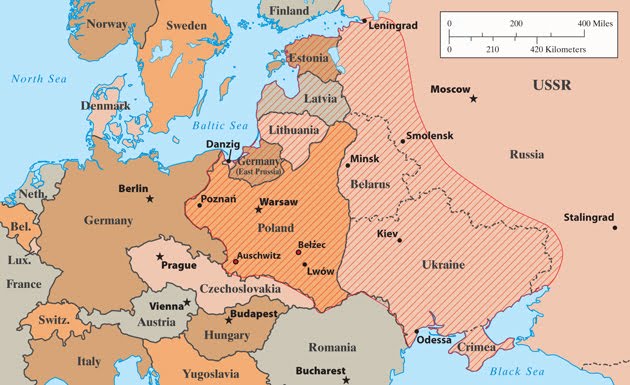
In 2012, Timothy Snyder’s Bloodlands proposed a social spatialisation of those countries and regions occupied in succession by both Nazi Germany and Stalin’s USSR. These form ‘killing fields’, a region of excessive death during the first half of the twentieth century especially 1933-45. This mass murder was by states, targeted according to ableist, racist, religious and political genocides of local populations: in total 14 million Jews, Roma, the disabled, dissidents, resistance fighters and military and intellectual elites but also ordinary citizens, children and elderly across vast swathes of what is now the Baltic States, Poland, Belorusse, Russia and Ukraine. This as and is “modern Europe’s central catastrophe, the murder of fourteen million people in a single time and place.” [409] Snyder points out that primitive means of killing, such as starvation by expropriating all food (over 7 million), shooting (over 1.5 million) or exhaustion through forced labour, exceeds those killed in the so-called industrialized killing camps such as Treblinka.
‘Bloodlands’ refers to the political geography of conflict and genocidal attacks on civilian populations in Eastern Europe, arguing that much less actual killing occurred in Germany, for example. Snyder attempts to reconnect the history of the Holocaust with its geography, where most of the death camps were in Poland, most of the deaths occurred in the western fringes of the USSR (Belorusse, Ukraine). The USSR’s Gulag of labour camps in Siberia is distinguished from the Bloodlands. He sets the Holocaust within a broader course of organized killing in the first half of the twentieth century with a particular emphasis on the role played by local militias, police officials and informers, arguing that this has conditioned the subsequent development of these societies and their rivalries and collaborations in ways that are not acknowledged.
“The Germans carried out all of their major killing policies on lands subsequently occupied by the Soviets. The Red Army liberated Auschit, and it liberated the sites of Trevlinka, Sobibór, Belzec, Chelmno and Majdanek…. It is not just that American and British forces saw none of the places where the Soviets killed…. It is that they never saw the places where the Germans killed, meaning that understanding of Hitler’s crimes ahs taken just as long.”
(xiv)
Snyder insists that these crimes not stand outside of history. “No past even is beyond historical understanding or the reach of historical inquiry.” [xviii] He argues that truth and facts must never be trumped by belief or horror. Nor should such deeds be justified by reference to a need to create a modern state, such as the USSR attempted. “This recalls Stalin’s view that history has only one course, which he understood, and which legitimates his politics in retrospect… Without a history built and defended upon an entirely different foundation, we will find that Hitler and Stalin continue to define their own works for us.” (xviii)
The book attends to the human geography of killing rather than the national divisions of a political geography which separates the history of each state from the other. Snyder is also committed to a turning the vast numbers of dead into unique humans living unique and valued lives. His method is a linear chronological model of time as the basis for historical research – essentially he brings together separate historical accounts of different groups in the same region to compare and contrast what happened.
“The bloodlands were no political territory, real or imagined; they are simply where Euorpoe’s most murderous regimes did their most murderous work…. The history of the bloodlands has been preserved by dividing the European past into national parts, and then by keeping these parts from touching one another. Yet attention to any single persecuted group, no matter how well executed as history will fail as an account of what happened in Europe between 1933 and 1945.”
(xviii-xix)
A spatial, geographical strategy is at the heart of Snyder’s book. It is reflected in the conceit bloodlands which cast these regions as a single place.
“there were familiar terms for only two of the killing politics: the Holocaust and the Soviet Great Terror… That the death pits of both were scattered across the same territories occurred to almost no one. Neither of the terms refers to a place…. My idea was to connect the history of both of these two more familiar crimes to their time and place, and to add to them, in proper chronological sequence, other mass killing politics that were less well-known. These included the starvation of Ukranians by Soviet power (1933), the oppression of Poles and Balts during the period when Germany and the Soviet Union were allies (1939-41), the starvation of Soviet prisoners of war by the Germans (1941-42), and the killing of Belarusian and Polish civilians by the Germans in anti-partisan actions (1942-44).”
Perhaps fortunately, the rubric ‘bloodlands’ has not stuck. It labels a set of nations from Estonia to Ukraine with the historical pall of crimes committed there but that were in many ways directed by the strategies of Berlin and Moscow. A decade later, from the vantage point of 2022, history appears more circular than linear. A government in Moscow in 2015, and again in 2022, pursues a policy of expropriation and war upon civilian centres in Ukraine. Some have pointed out that this war serves to distract the Russian population from the economic problems of their own economy, working out national issues in a zone beyond their border.
-Rob Shields (Univ. of Alberta)